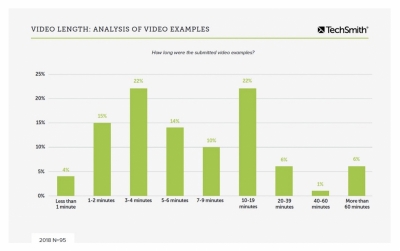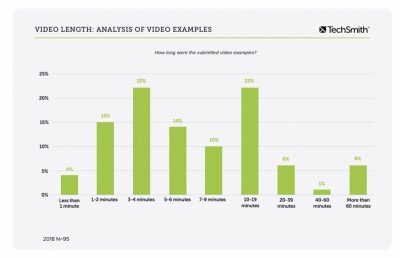Conventional wisdom says that when it comes to the length of your video, the shorter the better. In fact, many experts will tell you that two to three minutes is the video length sweet spot because you’ll lose viewers if your video is too long.
But is that really the case? Is a shorter video inherently better than a longer one?
While capturing and keeping a viewer’s attention can be difficult, as you might have guessed, the answer is a bit more complicated. The truth is, that there is no perfect video length for all videos, and shorter is not always better than longer. In fact, too short can be just as bad as too long if you fail to deliver the information your viewers need.
Instead of thinking about making your video shorter, think about right-sizing it.
The Goldilocks Principle
You likely know the story of famed breaker-and-enterer Goldilocks. After entering the Three Bears’ house, she found porridge that was either too hot or too cold and beds that were either too hard or too soft. But then she found the porridge that was just the right temperature and a bed that was just the right softness.
It was perfect. Until the bears showed up.
There’s a “just right” length for your video, too, and it’s…drum roll, please…the right size for YOUR video.
See, before you determine the length of your video, you need to figure out what you want to teach or explain. Some videos probably can do the job in a minute or even less, while other topics may take much longer to explain.
For example, a video showing how to log in to an e-mail account may only take a minute or two, but a video showing the steps to creating, addressing, and sending an e-mail likely will need more time.
Then you need to consider your audience. Going back to the e-mail example, a person who has been using computers and sending e-mails their whole life probably doesn’t need to know the nitty gritty details of what it means to compose and send an e-mail. They just need to know how to log in and then they’re on their way.
But imagine you are teaching your great-grandmother who has never used a computer. She’s going to need more time. And, in fact, she’ll probably need more than one video, so you don’t overwhelm her with new information.
Survey Says…
People will watch longer videos—but they need a reason to do it. TechSmith recently did a study of the habits and preferences of people who view instructional and informational videos, and we got some surprising results.

First, we found that more than 50 percent of people preferred a video length between three and six minutes.
That’s not really surprising—and it’s in keeping with the notion that shorter is better. But that’s not the whole story. The next highest preferred length was for videos in the 10- to 19-minute range. This strongly suggests people will watch longer videos if the content is what they’re looking for.

The research also analyzed nearly 100 videos that survey participants identified as examples of “great videos.” Of those, 22 percent were in that 10- to 19-minute range—the same percentage of those videos that were in the three to four-minute range.
The verdict? People will watch longer- videos, and they’ll even identify them as “great.”
How to Right-Size Your Video
When we ask about the perfect video length, what we’re really asking is, “How can I keep my viewers’ attention long enough to give them the information they need?”
And while viewers can get bored easily, that doesn’t mean it’s impossible to keep someone watching.
Turns out good content is still effective—we just have to provide it!
The No. 1 reason that people stop watching a video has nothing to do with the video length. In fact, 83 percent of the people we surveyed will continue to watch a video if they’re genuinely interested in the topic.
So the first step in keeping your audience engaged is to know what they’re looking for. Ask yourself these questions:
- Who is my audience?
- What problem are they trying to solve?
- What are their goals?
- What will they need from me to accomplish those goals?
- What is their skill level?
Then figure out the goal for your video based on the answers. How can you address them in the most effective and efficient way?
The biggest mistake most people make when they’re creating instructional or informational videos is that they try to do too much (or sometimes too little).
When you know what your audience needs and how to address it, you can plan your video accordingly. Be careful, though. You’re excited to share your knowledge, so it’s natural to want to share ALL of it. Remember, you want to create a video that addresses a specific problem or topic. Make sure you create a video that does that and nothing more.
That doesn’t mean the other information isn’t important. It just means you’ll want to share other information in other videos. No one ever said you had to make just one video. Make as many as you need to address as many topics, problems, pain points, etc., as necessary.
Your viewers will thank you (and keep coming back for more).
Mystery Solved
You now know that when you’re planning your instructional or training video, deciding on how long it should be before you know more about your topic and audience is a little bit like putting the cart before the horse.
Think carefully about what you need to teach, as well as your audience’s needs, skill level, and prior knowledge or experience. Then create a video that solves their problem. If you need to make other videos, you can do that, too.
Matt Pierce is Learning & Video ambassador at TechSmith Corp., the go-to company for visual communication. TechSmith empowers people to create remarkable content to share knowledge and information. A graduate of Indiana University’s School of Education’s Department of Instructional Systems Technology, Pierce has more than 10 years of experience working in learning and development with a focus on visual instruction. He has directly managed the training, user assistance, video, and other teams for TechSmith.




